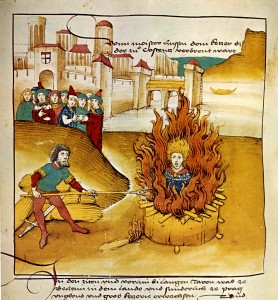 I don’t know how about you, but I personally don’t remember much about the history of the Czech language. All I remember from the school days is ” blah blah blah…Constantine and Methodius…blah blah blah…Jan Hus burnt at the stake…..blah,blah,blah…ding-dong!!!! (the school bell finally rings)”. Now that I am older, I find myself finding this information actually interesting and I retain some of the stuff too! Here is some light lecture on the history of our language that I found (I already cut out some ‘non-important’ parts so hopefully I am not going to bore you too much!).
I don’t know how about you, but I personally don’t remember much about the history of the Czech language. All I remember from the school days is ” blah blah blah…Constantine and Methodius…blah blah blah…Jan Hus burnt at the stake…..blah,blah,blah…ding-dong!!!! (the school bell finally rings)”. Now that I am older, I find myself finding this information actually interesting and I retain some of the stuff too! Here is some light lecture on the history of our language that I found (I already cut out some ‘non-important’ parts so hopefully I am not going to bore you too much!).
CZ: Ja nevim jak vy, ale ja si z historie ceskeho jazyka moc nepamatuju. Jedine co se mi vybavuje je: “bla,bla,bla..Jan Hus upalen….bla,bla,bla….Ciril a Metodej….bla,bla,bla….crrrrrr!!!! (hodina je konecne u konce)”. Cim starsi ale jsem, tim vic me tyto veci zajimaji – a dokonce si i z toho co studuju neco zapamatuju!! Tady je velmi kratka a lehoucka lekce o tom, jak ten nas jazyk vlastne vznikl (doufam, ze vas neunudim k smrti):
Czech together with Slovak, Polish and Serbian languages is called the western group of Slavic languages. They are related to the languages of the east Slavic group such as Russian or the southern Slavic group like Bulgarian, Serbian and Croatian. To be more specific, it belongs to the eastern division of Indo-European languages. How did it separate from the other Slavic languages? Most of the changes appeared already in the 10th century and continued well into the 16th century. Among the most obvious changes were:
- a –> e (dusa –> duse)
- g –> h (noga –> noha)
- uo –> u (duom –> dum)
- aj –> ej (vajce –> vejce)
- and so on…
By the end of the 15th century Czech had lost 2 Slavic past tenses (yes!) but made it up by creating even more declinations (o-oh..). What’s interesting is that the medieval Latin alphabet was used to write down the Czech names as well as the first commentaries until the 13the century. Once the Czech text became more sophisticated, a new, mixed writing system appeared (such as digraphs: ‘ch’) to mark down Czech sounds which had no equivalent in Latin alphabet. Jan Hus finally made an order in this ‘mess’ and created an official diacritical writing system, meaning that he placed diacritical marks (hacky,carky) over some Latin letters.
The Czech language has been influenced by many languages such as the Old Church Slavonic (introduced by Constantine and Methodius in the 9th century), Latin and German (the main language of the Hapsburg empire). Ever since the 14th century, Czech language has been producing a constant stream of various writings and books, except for the time when Czech became a province of the Hapsburg Empire. For those who like to know interesting facts, the first Czech dictionary came out in the 14th century and the first Czech grammar book came out in 1533.
Are you asleep yet??
Source: http://www.czech-language.cz/overview/origin.html
If you liked this post buy me a coffee! (Suggested:$3 a latte $8 for a pound) Thanks!




No, not asleep. Not even close.
I am glad! I saw you just posted your 200th post – good going!!
History of the Czech language is very interesting.
Sometimes I even see that Czech language has some similarities with American English…
Vau, to je docela kuul…
I just left a comment and it disappeared on me..I hate that! Anyway, what I was trying to say is that it is pretty cool that we are the only nation that has the letter ‘r (plus hacek)’ – well, you know, what I mean, right? Here is a little somethin’ to celebrate it: Trista tricet stribrnych strikacek strikalo pres trista tricet stribrnych strech!!!” 😉
Ano, ‘r (plus hacek)’ byl tvrdy orisek pro mou ruskou manzelku. Ted us umi tu rikanku s temi 333 strikackami :)) Moje deti, ktere cesky mlivi tak nizna 3 hodiny za rok, r s hackem ovladaji perfektne…
Jinak samozrejme hazkey se pouzivaji i v jinych jazycich… Moje dcera miluje cestinu pro “zdrobneliny”….neni to sice typicky ceske, ale je to typicky cesky mile :)))
Zakomave je “h” a “ch”. Ve vetsihe slovanskych jazycich, “h” neexistuje…
“ch” existuje snad ve vsech slovanskych jazycich, a ceske “h” ve vetsine podobnych slovanskych slovech figutuje jako “g”, ktere se “nevzdelanymi” lidmi vyslovuje jako ceske “h”…. Neni to uzasne???
Tanjo, you and I have never differed before on this website and it pains me to do so here for the first time (I’m almost devastated . . . but I’ll get over it). This unique gem of a letter ‘r with hacek, is really not what you think and perhaps ought not to be extolled with such enthusiasm. Who knows how many past emperors, impressed with good czech beers have used this particular letter to get good and lathered up about it and send their rampaging armies across the bohemian landscape. Who knew? I personally rampage inside my head every time I have to use it!
Did you have a little talk with Jan Hus about this when you went to Tabor? Who knows, if a lot of people complain to to him about this, maybe he is going to wake up from the dead and make an end to this craziness! But then again, we – the Czechs – would not be that special anymore 🙁
Oh, myslim ze ne, that you would lose your specialness over the haceked ‘r’. Just think of that beer, the moon over Hradcany a Vltava, Mikulov namesti, Tabor a Jan Zizka, Cesky Krumlov’s sundials, the flowers of Marianske Lazne. The list goes on and on and this isn’t even mentioning that famous Czech sense of humor.
Mila Tanjo,
k zapadnim slovanskym jazykum patri luzicka srbstina, ne sbrstina z byvale Jugoslavie. Ta patri k jiznim slovanskym jazykum. Luzicka srbstina se pise latinkou a ma podobnou strukturu jako cestina. Srbstina z jihu je naprosro odlisna a pise se “azbukou”. Luzicti Srbove chteli byt po 2.svetove valce pripojeni k Ceskoslovensku, pro blizkost jazyka a kultur. Ale nedoslo k tomu mimo jine kvuli zajmum Ruska.V anglictine se pro luzickou srbstinu nekdy pouziva vyrazu WENDISH. Mluvi ji neco kolem 60.000 lidi.
PS. Pokud neznate http://www.rodina.cz, kouknete se na ni. Je tam suplicek pod titulem Maminky jinde…(nahoda?)
Vera S.
Vlastimil March : ” Zakomave je “h” a “ch”. Ve vetsihe slovanskych jazycich, “h” neexistuje…
“ch” existuje snad ve vsech slovanskych jazycich, a ceske “h” ve vetsine podobnych slovanskych slovech figutuje jako “g”, ktere se “nevzdelanymi” lidmi vyslovuje jako ceske “h”…. Neni to uzasne???”
Prrrr! Hold yer horseys!
Hrvati rikaji “H”, ne “CH”, viz “hvala”. Srbi to same, nezminujice se o Slovincich (Or Slovenech, jak se raci). Yea, “gora” je s “G”, ale to nemeni nic ma pouziti “H” v miste “CH”, wide and far, u Jihozapadnich Slovanu..
Volhans (Rusi na Volze) reknou “Volhohrad, ne “Volgograd”. Horod heroj Volhohrad. Predpokladam ze jsou to ti oznaceni jako nevzdelani… legracni je ze tohle uziti je predominantni na tamejsi universite.
Vero, Hrvati (Slovene take) pisou latinkou. Je to prakticky ten samy jazyk jako Srbove maji (z toho >Srbo-chorvatstina), s nejakymi regionalnimi odlistnostmi. Hlavni rozdil: Hrvati – katolici, latinka; Srbi – pravoslavni, azbuka. Take, they hate each other’s guts.
Zapomel jsem na Ukraince a Rusiny. “H” se pouziva ostosest v miste “G”. “Г” se vyslovuje “H” (na rozdil od Rustiny) a “Ґ” (se zobackem) se vyslovuje “G”. “Dobrego” je ysloveno “dobreho”.
Takze, to “Ř” se zda je pouze jedina Ceska specialita (foneticky), pokud nepripustime Polske “RZ” ktere je tak nejak ani ryba ani rak.